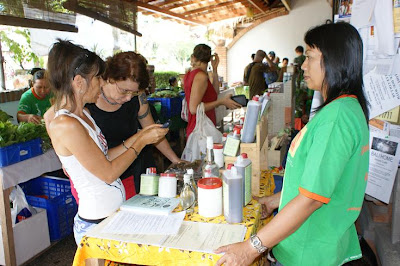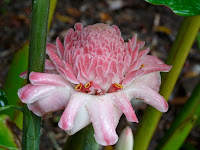
Although Renate just had moved to the place the day before she was already very well organized and started giving us some information on the path that led her to Bali and on her vision for the project. Have a look at her website for more information. After 4 years of travelling and preparing she had decided to make the property in Bondalem her new base for living and began to draw the plans of a healing place inspired by the clarity and calmness of zen monasteries. As she is not a professional designer she let an architect go over her sketches and draw the final plans to get the permit for construction. To help understanding the plans and communicating them to the workers Renate had made a colorful paper model of the buildings.

The main theme of the place is water: the healing power of the ocean nearby combined with a special water therapy for which a 35 degree Celsius warm pool is built and a regular swimming pool. Xavier, an experienced water therapist and as such very aware of water quality, explained us the challenges a pool designer is faced with. Luckily in Bali we usually can enjoy good water quality. Our skin is not waterproof, there is an exchange of molecules through the skin with the surrounding water. Infinity pools have the advantage that the chlorine gas which usually floats above the water level right in the area where we breathe can drift away while it is trapped by the surrounding wall in skimmer pools. There are various water treatment technologies, many of them not available though in Bali. So it is wise to choose a system that is available and can be maintained locally which are pool ionizers. The swimming pool contractor from Denpasar which was expected for 4pm does not show up. The holiday of Kuningan the day before might be a reason.



After the introduction Renate guided us through the construction site where her contractor Pak Willis, another sweet Balinese guy, explained how he liked working for Renate and excused himself for any misunderstandings and not progressing faster. Everything needs time. Yes, and then it was time for lunch. The javanese workers had grilled 2 big fresh fish and the kitchen fairies had prepared wonderful salads, fritters and rice for us. What a delight!

After lunch some of the participants had to leave and the rest of us shared some information:
- Beate told us about her traditional Bali rice project. The rice has already been harvested. As the halms are higher than the fast growing species it is harvested in an upright position, back straight, not bent, with a special knife. After the rice is dry enough it will be gedrescht in the traditional way.
- Beate informed that she received a generous donation for her children project. The children and the people from the village would like to use the money for public toilets and a waste water garden in the village
- Beate talked with members of the environment department in Denpasar about the waste problem. They are really interested in supporting a project. So Beate asks us for help in designing a waste treatment system for Buleleng.
- Evelyn shared some insights from the PDC with Bill Mollison which she attended in Melbourne lately.
- Then we talked about solar energy. Renate showed us the brochures of Contained Energy which offers now solutions in Bali. The problem with solar energy very often is storage of the energy for the time when the sun is not shining. Batteries are needed which are expensive and tend to break. Burkhard recommends to bring down the peak energy usage by not using all the power consumers together. Like this a contract for less KW can be agreed on with PLN.
- We discussed strategies how to interact with the local communities. Sometimes our good intentions can lead to aversion by the local community if we don't integrate them very carefully into the projects. Watch out for open doors and open minds!
- Nicole distributes an introduction into MET (Meridian Energy Techniques), an easy-to-learn method for dealing with stress and fears.
- Renate told us how the coconut poles were made termite-safe. They split the poles and filled them with cement and iron and put them together again.
- On the way back we stopped at Bali Mandala Resort to return a pair of shoes following the permaculture desing principle: every element, like in our case the ride home, supports more than one function!
Please note the date for the next meeting: Sunday, November 15, 2009. The venue is not yet clear. Maybe Beate's place in Manuksesa. An information will follow by Renate a few days before.





































